Global Supply Chain: Distribution, Vendors, and E-Business
VerifiedAdded on 2022/12/28
|13
|4254
|3
Homework Assignment
AI Summary
This assignment delves into the intricacies of global supply chains, examining how firms adopt appropriate distribution networks to achieve their objectives. It explores the differences in retail environments, comparing the contexts of India, the UK, and the US, and analyzes various distribution channels, distinguishing between direct and indirect approaches suitable for different product types. The assignment also investigates the reasons behind the greater success of e-business in the PC industry compared to the grocery industry, considering factors such as product characteristics, networking, and consumer behavior. Furthermore, it assesses the importance of effective supplier relationship management in contributing to a firm's competitive advantages, highlighting the benefits of healthy vendor relationships, including cost savings, vendor support, customization opportunities, efficiency gains, supply chain consolidations, and problem resolution. The assignment also outlines key vendor selection criteria, crucial for building successful supply chains.
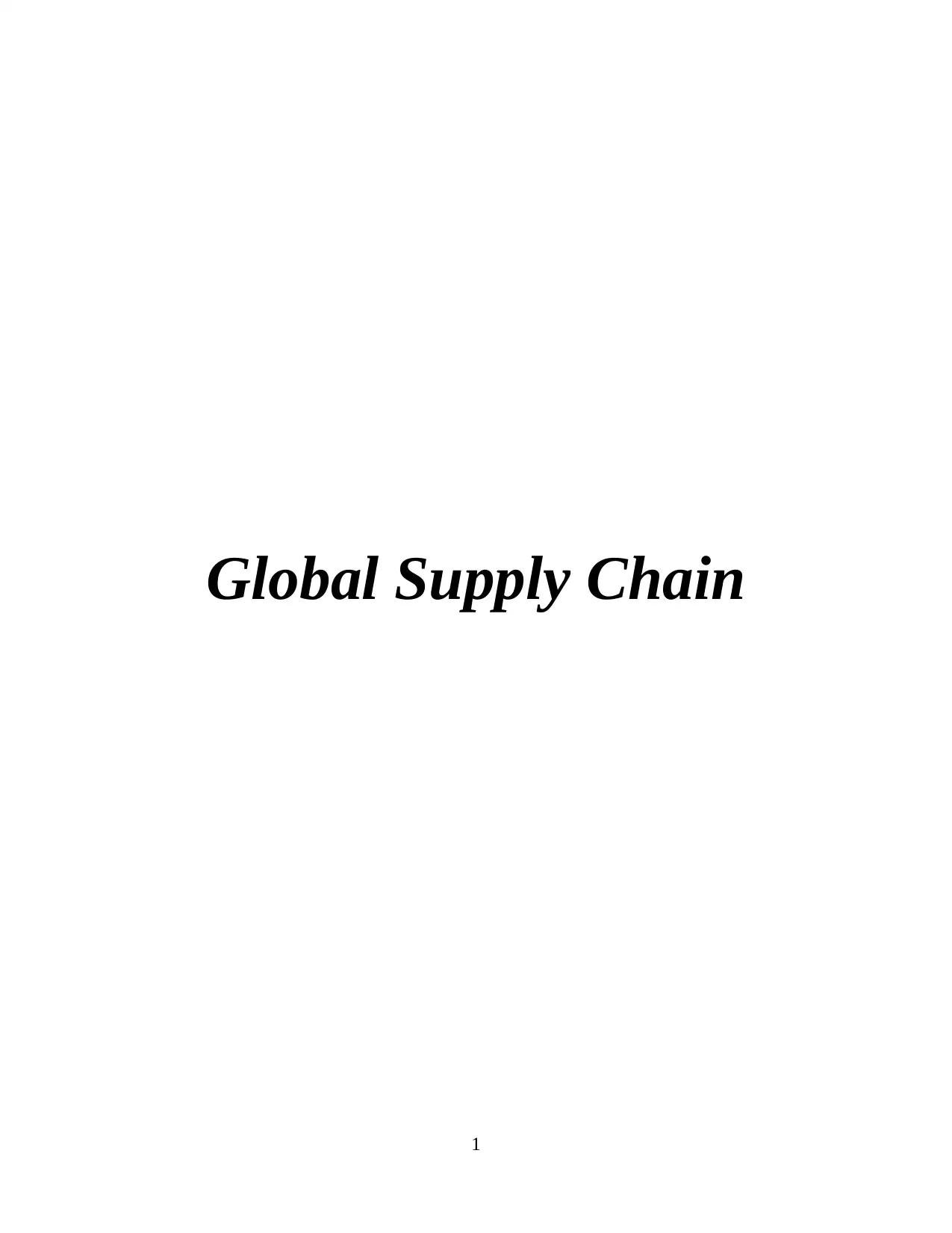
Global Supply Chain
1
1
Paraphrase This Document
Need a fresh take? Get an instant paraphrase of this document with our AI Paraphraser
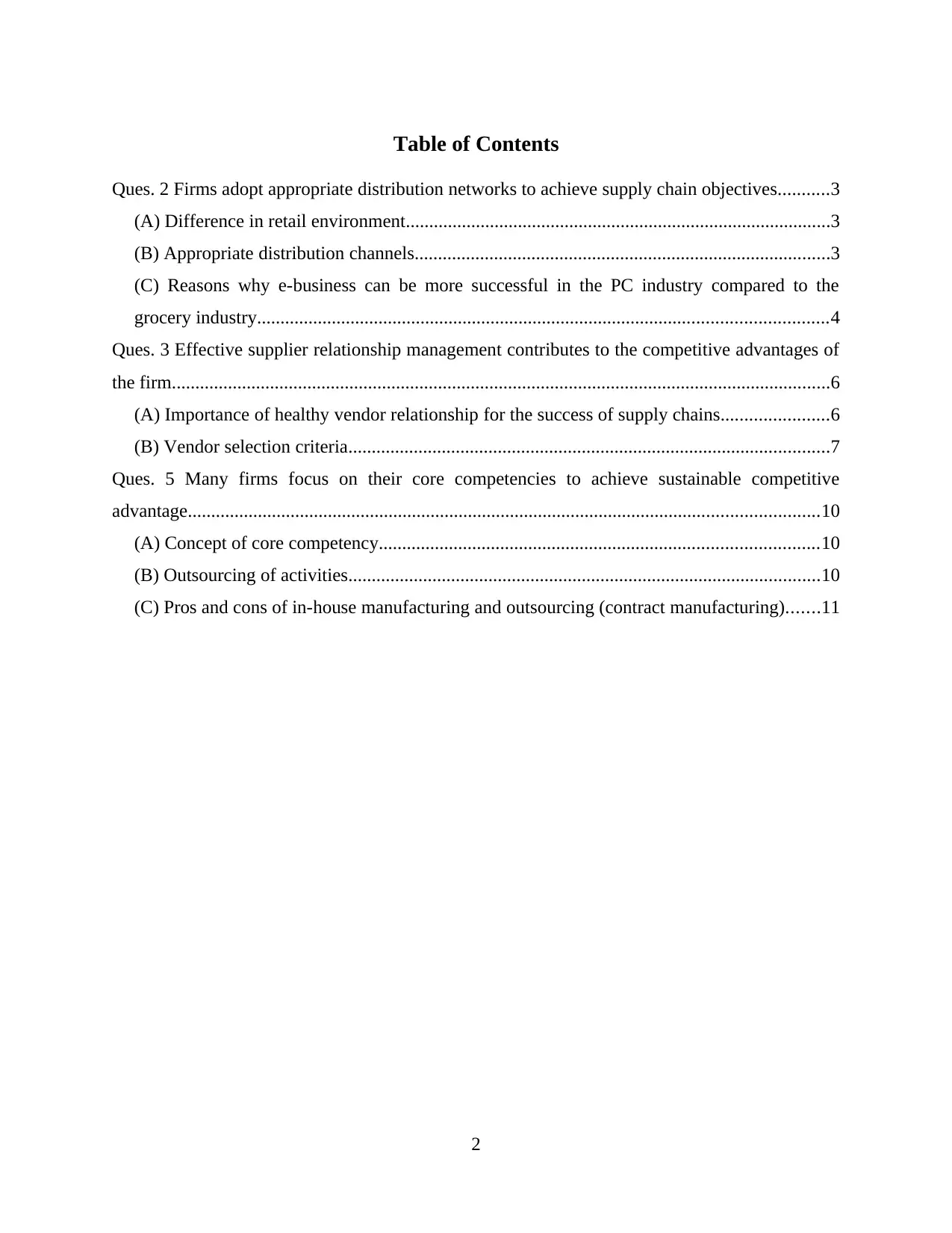
Table of Contents
Ques. 2 Firms adopt appropriate distribution networks to achieve supply chain objectives...........3
(A) Difference in retail environment...........................................................................................3
(B) Appropriate distribution channels.........................................................................................3
(C) Reasons why e-business can be more successful in the PC industry compared to the
grocery industry..........................................................................................................................4
Ques. 3 Effective supplier relationship management contributes to the competitive advantages of
the firm.............................................................................................................................................6
(A) Importance of healthy vendor relationship for the success of supply chains.......................6
(B) Vendor selection criteria.......................................................................................................7
Ques. 5 Many firms focus on their core competencies to achieve sustainable competitive
advantage.......................................................................................................................................10
(A) Concept of core competency..............................................................................................10
(B) Outsourcing of activities.....................................................................................................10
(C) Pros and cons of in-house manufacturing and outsourcing (contract manufacturing).......11
2
Ques. 2 Firms adopt appropriate distribution networks to achieve supply chain objectives...........3
(A) Difference in retail environment...........................................................................................3
(B) Appropriate distribution channels.........................................................................................3
(C) Reasons why e-business can be more successful in the PC industry compared to the
grocery industry..........................................................................................................................4
Ques. 3 Effective supplier relationship management contributes to the competitive advantages of
the firm.............................................................................................................................................6
(A) Importance of healthy vendor relationship for the success of supply chains.......................6
(B) Vendor selection criteria.......................................................................................................7
Ques. 5 Many firms focus on their core competencies to achieve sustainable competitive
advantage.......................................................................................................................................10
(A) Concept of core competency..............................................................................................10
(B) Outsourcing of activities.....................................................................................................10
(C) Pros and cons of in-house manufacturing and outsourcing (contract manufacturing).......11
2
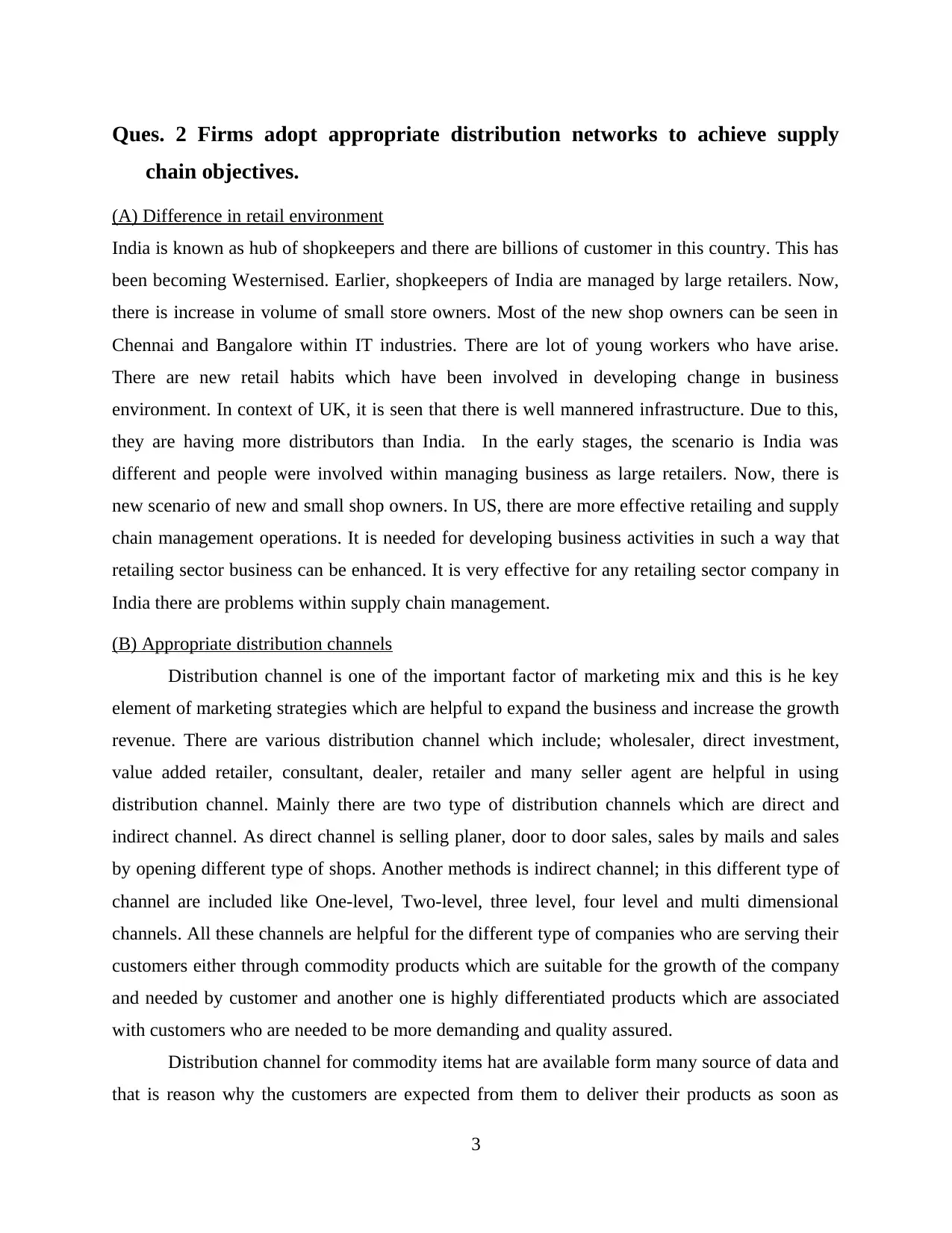
Ques. 2 Firms adopt appropriate distribution networks to achieve supply
chain objectives.
(A) Difference in retail environment
India is known as hub of shopkeepers and there are billions of customer in this country. This has
been becoming Westernised. Earlier, shopkeepers of India are managed by large retailers. Now,
there is increase in volume of small store owners. Most of the new shop owners can be seen in
Chennai and Bangalore within IT industries. There are lot of young workers who have arise.
There are new retail habits which have been involved in developing change in business
environment. In context of UK, it is seen that there is well mannered infrastructure. Due to this,
they are having more distributors than India. In the early stages, the scenario is India was
different and people were involved within managing business as large retailers. Now, there is
new scenario of new and small shop owners. In US, there are more effective retailing and supply
chain management operations. It is needed for developing business activities in such a way that
retailing sector business can be enhanced. It is very effective for any retailing sector company in
India there are problems within supply chain management.
(B) Appropriate distribution channels
Distribution channel is one of the important factor of marketing mix and this is he key
element of marketing strategies which are helpful to expand the business and increase the growth
revenue. There are various distribution channel which include; wholesaler, direct investment,
value added retailer, consultant, dealer, retailer and many seller agent are helpful in using
distribution channel. Mainly there are two type of distribution channels which are direct and
indirect channel. As direct channel is selling planer, door to door sales, sales by mails and sales
by opening different type of shops. Another methods is indirect channel; in this different type of
channel are included like One-level, Two-level, three level, four level and multi dimensional
channels. All these channels are helpful for the different type of companies who are serving their
customers either through commodity products which are suitable for the growth of the company
and needed by customer and another one is highly differentiated products which are associated
with customers who are needed to be more demanding and quality assured.
Distribution channel for commodity items hat are available form many source of data and
that is reason why the customers are expected from them to deliver their products as soon as
3
chain objectives.
(A) Difference in retail environment
India is known as hub of shopkeepers and there are billions of customer in this country. This has
been becoming Westernised. Earlier, shopkeepers of India are managed by large retailers. Now,
there is increase in volume of small store owners. Most of the new shop owners can be seen in
Chennai and Bangalore within IT industries. There are lot of young workers who have arise.
There are new retail habits which have been involved in developing change in business
environment. In context of UK, it is seen that there is well mannered infrastructure. Due to this,
they are having more distributors than India. In the early stages, the scenario is India was
different and people were involved within managing business as large retailers. Now, there is
new scenario of new and small shop owners. In US, there are more effective retailing and supply
chain management operations. It is needed for developing business activities in such a way that
retailing sector business can be enhanced. It is very effective for any retailing sector company in
India there are problems within supply chain management.
(B) Appropriate distribution channels
Distribution channel is one of the important factor of marketing mix and this is he key
element of marketing strategies which are helpful to expand the business and increase the growth
revenue. There are various distribution channel which include; wholesaler, direct investment,
value added retailer, consultant, dealer, retailer and many seller agent are helpful in using
distribution channel. Mainly there are two type of distribution channels which are direct and
indirect channel. As direct channel is selling planer, door to door sales, sales by mails and sales
by opening different type of shops. Another methods is indirect channel; in this different type of
channel are included like One-level, Two-level, three level, four level and multi dimensional
channels. All these channels are helpful for the different type of companies who are serving their
customers either through commodity products which are suitable for the growth of the company
and needed by customer and another one is highly differentiated products which are associated
with customers who are needed to be more demanding and quality assured.
Distribution channel for commodity items hat are available form many source of data and
that is reason why the customers are expected from them to deliver their products as soon as
3
⊘ This is a preview!⊘
Do you want full access?
Subscribe today to unlock all pages.

Trusted by 1+ million students worldwide
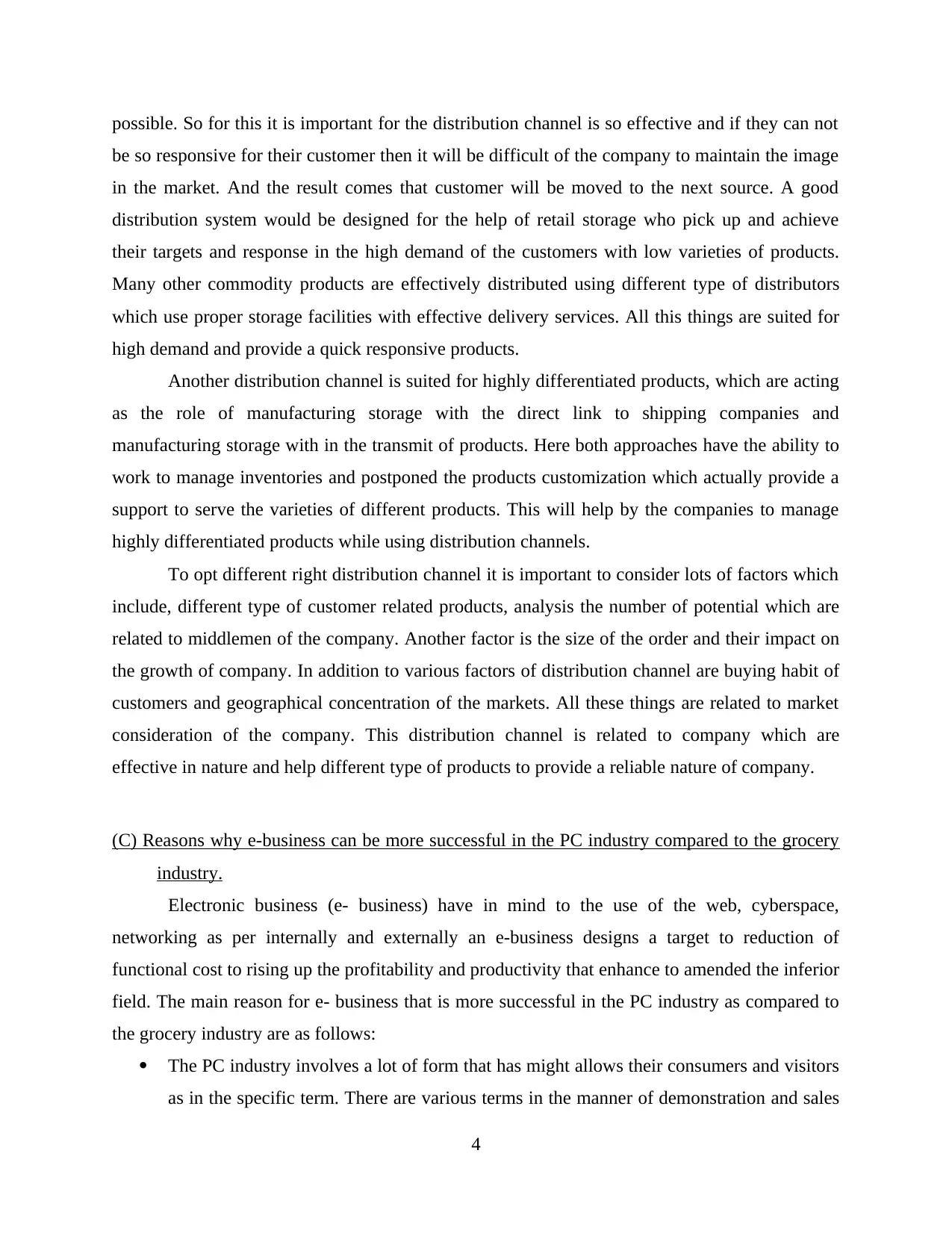
possible. So for this it is important for the distribution channel is so effective and if they can not
be so responsive for their customer then it will be difficult of the company to maintain the image
in the market. And the result comes that customer will be moved to the next source. A good
distribution system would be designed for the help of retail storage who pick up and achieve
their targets and response in the high demand of the customers with low varieties of products.
Many other commodity products are effectively distributed using different type of distributors
which use proper storage facilities with effective delivery services. All this things are suited for
high demand and provide a quick responsive products.
Another distribution channel is suited for highly differentiated products, which are acting
as the role of manufacturing storage with the direct link to shipping companies and
manufacturing storage with in the transmit of products. Here both approaches have the ability to
work to manage inventories and postponed the products customization which actually provide a
support to serve the varieties of different products. This will help by the companies to manage
highly differentiated products while using distribution channels.
To opt different right distribution channel it is important to consider lots of factors which
include, different type of customer related products, analysis the number of potential which are
related to middlemen of the company. Another factor is the size of the order and their impact on
the growth of company. In addition to various factors of distribution channel are buying habit of
customers and geographical concentration of the markets. All these things are related to market
consideration of the company. This distribution channel is related to company which are
effective in nature and help different type of products to provide a reliable nature of company.
(C) Reasons why e-business can be more successful in the PC industry compared to the grocery
industry.
Electronic business (e- business) have in mind to the use of the web, cyberspace,
networking as per internally and externally an e-business designs a target to reduction of
functional cost to rising up the profitability and productivity that enhance to amended the inferior
field. The main reason for e- business that is more successful in the PC industry as compared to
the grocery industry are as follows:
The PC industry involves a lot of form that has might allows their consumers and visitors
as in the specific term. There are various terms in the manner of demonstration and sales
4
be so responsive for their customer then it will be difficult of the company to maintain the image
in the market. And the result comes that customer will be moved to the next source. A good
distribution system would be designed for the help of retail storage who pick up and achieve
their targets and response in the high demand of the customers with low varieties of products.
Many other commodity products are effectively distributed using different type of distributors
which use proper storage facilities with effective delivery services. All this things are suited for
high demand and provide a quick responsive products.
Another distribution channel is suited for highly differentiated products, which are acting
as the role of manufacturing storage with the direct link to shipping companies and
manufacturing storage with in the transmit of products. Here both approaches have the ability to
work to manage inventories and postponed the products customization which actually provide a
support to serve the varieties of different products. This will help by the companies to manage
highly differentiated products while using distribution channels.
To opt different right distribution channel it is important to consider lots of factors which
include, different type of customer related products, analysis the number of potential which are
related to middlemen of the company. Another factor is the size of the order and their impact on
the growth of company. In addition to various factors of distribution channel are buying habit of
customers and geographical concentration of the markets. All these things are related to market
consideration of the company. This distribution channel is related to company which are
effective in nature and help different type of products to provide a reliable nature of company.
(C) Reasons why e-business can be more successful in the PC industry compared to the grocery
industry.
Electronic business (e- business) have in mind to the use of the web, cyberspace,
networking as per internally and externally an e-business designs a target to reduction of
functional cost to rising up the profitability and productivity that enhance to amended the inferior
field. The main reason for e- business that is more successful in the PC industry as compared to
the grocery industry are as follows:
The PC industry involves a lot of form that has might allows their consumers and visitors
as in the specific term. There are various terms in the manner of demonstration and sales
4
Paraphrase This Document
Need a fresh take? Get an instant paraphrase of this document with our AI Paraphraser
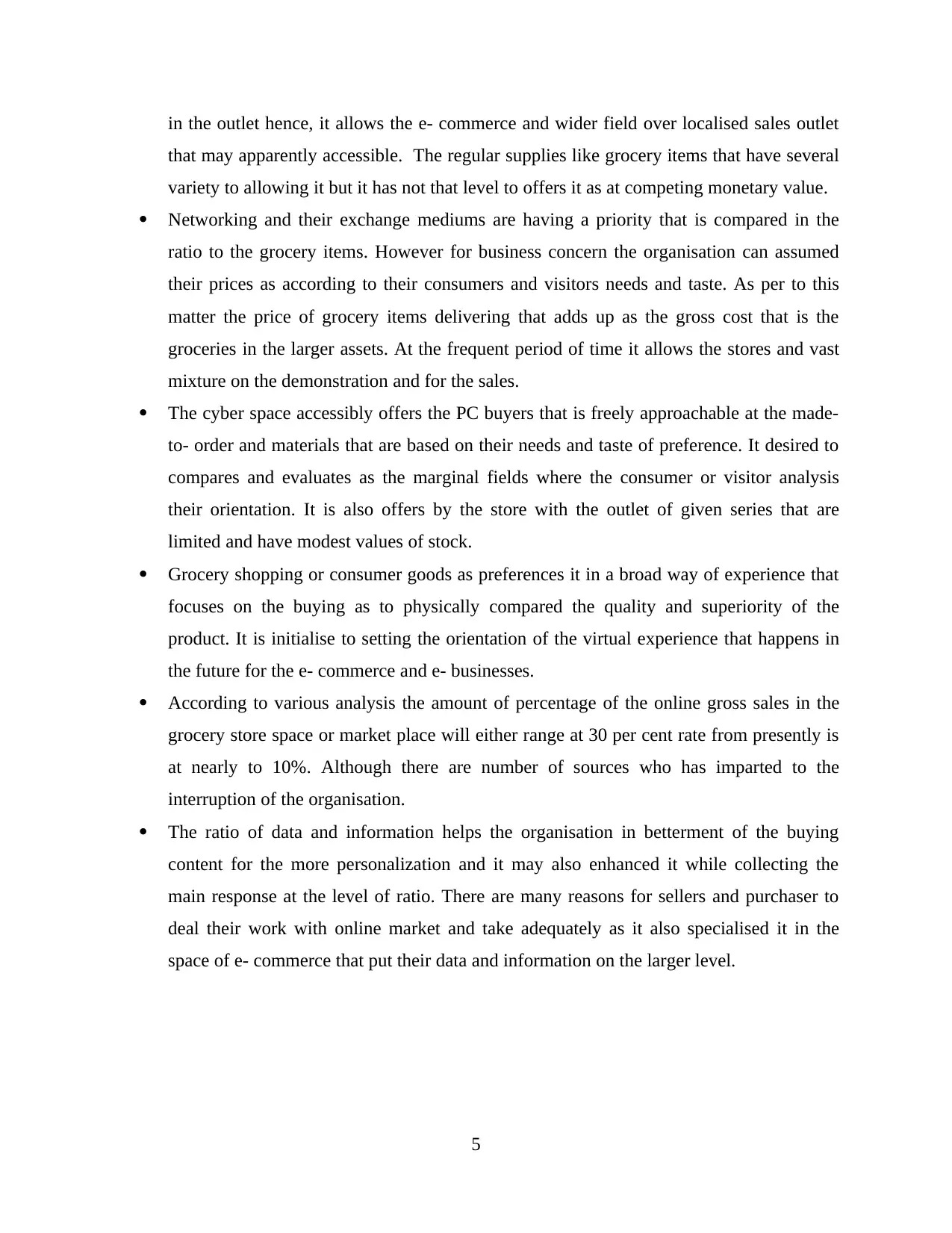
in the outlet hence, it allows the e- commerce and wider field over localised sales outlet
that may apparently accessible. The regular supplies like grocery items that have several
variety to allowing it but it has not that level to offers it as at competing monetary value.
Networking and their exchange mediums are having a priority that is compared in the
ratio to the grocery items. However for business concern the organisation can assumed
their prices as according to their consumers and visitors needs and taste. As per to this
matter the price of grocery items delivering that adds up as the gross cost that is the
groceries in the larger assets. At the frequent period of time it allows the stores and vast
mixture on the demonstration and for the sales.
The cyber space accessibly offers the PC buyers that is freely approachable at the made-
to- order and materials that are based on their needs and taste of preference. It desired to
compares and evaluates as the marginal fields where the consumer or visitor analysis
their orientation. It is also offers by the store with the outlet of given series that are
limited and have modest values of stock.
Grocery shopping or consumer goods as preferences it in a broad way of experience that
focuses on the buying as to physically compared the quality and superiority of the
product. It is initialise to setting the orientation of the virtual experience that happens in
the future for the e- commerce and e- businesses.
According to various analysis the amount of percentage of the online gross sales in the
grocery store space or market place will either range at 30 per cent rate from presently is
at nearly to 10%. Although there are number of sources who has imparted to the
interruption of the organisation.
The ratio of data and information helps the organisation in betterment of the buying
content for the more personalization and it may also enhanced it while collecting the
main response at the level of ratio. There are many reasons for sellers and purchaser to
deal their work with online market and take adequately as it also specialised it in the
space of e- commerce that put their data and information on the larger level.
5
that may apparently accessible. The regular supplies like grocery items that have several
variety to allowing it but it has not that level to offers it as at competing monetary value.
Networking and their exchange mediums are having a priority that is compared in the
ratio to the grocery items. However for business concern the organisation can assumed
their prices as according to their consumers and visitors needs and taste. As per to this
matter the price of grocery items delivering that adds up as the gross cost that is the
groceries in the larger assets. At the frequent period of time it allows the stores and vast
mixture on the demonstration and for the sales.
The cyber space accessibly offers the PC buyers that is freely approachable at the made-
to- order and materials that are based on their needs and taste of preference. It desired to
compares and evaluates as the marginal fields where the consumer or visitor analysis
their orientation. It is also offers by the store with the outlet of given series that are
limited and have modest values of stock.
Grocery shopping or consumer goods as preferences it in a broad way of experience that
focuses on the buying as to physically compared the quality and superiority of the
product. It is initialise to setting the orientation of the virtual experience that happens in
the future for the e- commerce and e- businesses.
According to various analysis the amount of percentage of the online gross sales in the
grocery store space or market place will either range at 30 per cent rate from presently is
at nearly to 10%. Although there are number of sources who has imparted to the
interruption of the organisation.
The ratio of data and information helps the organisation in betterment of the buying
content for the more personalization and it may also enhanced it while collecting the
main response at the level of ratio. There are many reasons for sellers and purchaser to
deal their work with online market and take adequately as it also specialised it in the
space of e- commerce that put their data and information on the larger level.
5
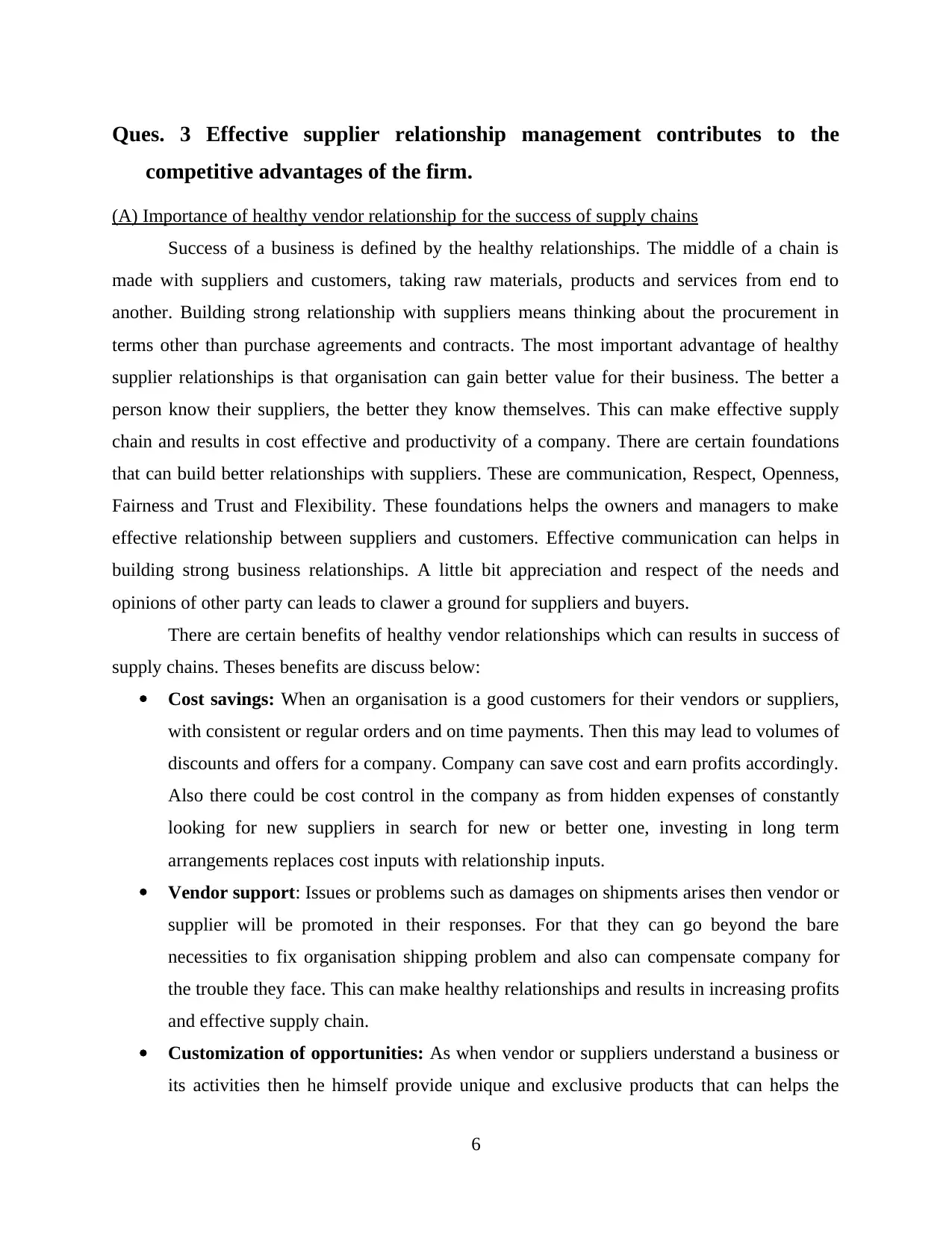
Ques. 3 Effective supplier relationship management contributes to the
competitive advantages of the firm.
(A) Importance of healthy vendor relationship for the success of supply chains
Success of a business is defined by the healthy relationships. The middle of a chain is
made with suppliers and customers, taking raw materials, products and services from end to
another. Building strong relationship with suppliers means thinking about the procurement in
terms other than purchase agreements and contracts. The most important advantage of healthy
supplier relationships is that organisation can gain better value for their business. The better a
person know their suppliers, the better they know themselves. This can make effective supply
chain and results in cost effective and productivity of a company. There are certain foundations
that can build better relationships with suppliers. These are communication, Respect, Openness,
Fairness and Trust and Flexibility. These foundations helps the owners and managers to make
effective relationship between suppliers and customers. Effective communication can helps in
building strong business relationships. A little bit appreciation and respect of the needs and
opinions of other party can leads to clawer a ground for suppliers and buyers.
There are certain benefits of healthy vendor relationships which can results in success of
supply chains. Theses benefits are discuss below:
Cost savings: When an organisation is a good customers for their vendors or suppliers,
with consistent or regular orders and on time payments. Then this may lead to volumes of
discounts and offers for a company. Company can save cost and earn profits accordingly.
Also there could be cost control in the company as from hidden expenses of constantly
looking for new suppliers in search for new or better one, investing in long term
arrangements replaces cost inputs with relationship inputs.
Vendor support: Issues or problems such as damages on shipments arises then vendor or
supplier will be promoted in their responses. For that they can go beyond the bare
necessities to fix organisation shipping problem and also can compensate company for
the trouble they face. This can make healthy relationships and results in increasing profits
and effective supply chain.
Customization of opportunities: As when vendor or suppliers understand a business or
its activities then he himself provide unique and exclusive products that can helps the
6
competitive advantages of the firm.
(A) Importance of healthy vendor relationship for the success of supply chains
Success of a business is defined by the healthy relationships. The middle of a chain is
made with suppliers and customers, taking raw materials, products and services from end to
another. Building strong relationship with suppliers means thinking about the procurement in
terms other than purchase agreements and contracts. The most important advantage of healthy
supplier relationships is that organisation can gain better value for their business. The better a
person know their suppliers, the better they know themselves. This can make effective supply
chain and results in cost effective and productivity of a company. There are certain foundations
that can build better relationships with suppliers. These are communication, Respect, Openness,
Fairness and Trust and Flexibility. These foundations helps the owners and managers to make
effective relationship between suppliers and customers. Effective communication can helps in
building strong business relationships. A little bit appreciation and respect of the needs and
opinions of other party can leads to clawer a ground for suppliers and buyers.
There are certain benefits of healthy vendor relationships which can results in success of
supply chains. Theses benefits are discuss below:
Cost savings: When an organisation is a good customers for their vendors or suppliers,
with consistent or regular orders and on time payments. Then this may lead to volumes of
discounts and offers for a company. Company can save cost and earn profits accordingly.
Also there could be cost control in the company as from hidden expenses of constantly
looking for new suppliers in search for new or better one, investing in long term
arrangements replaces cost inputs with relationship inputs.
Vendor support: Issues or problems such as damages on shipments arises then vendor or
supplier will be promoted in their responses. For that they can go beyond the bare
necessities to fix organisation shipping problem and also can compensate company for
the trouble they face. This can make healthy relationships and results in increasing profits
and effective supply chain.
Customization of opportunities: As when vendor or suppliers understand a business or
its activities then he himself provide unique and exclusive products that can helps the
6
⊘ This is a preview!⊘
Do you want full access?
Subscribe today to unlock all pages.

Trusted by 1+ million students worldwide
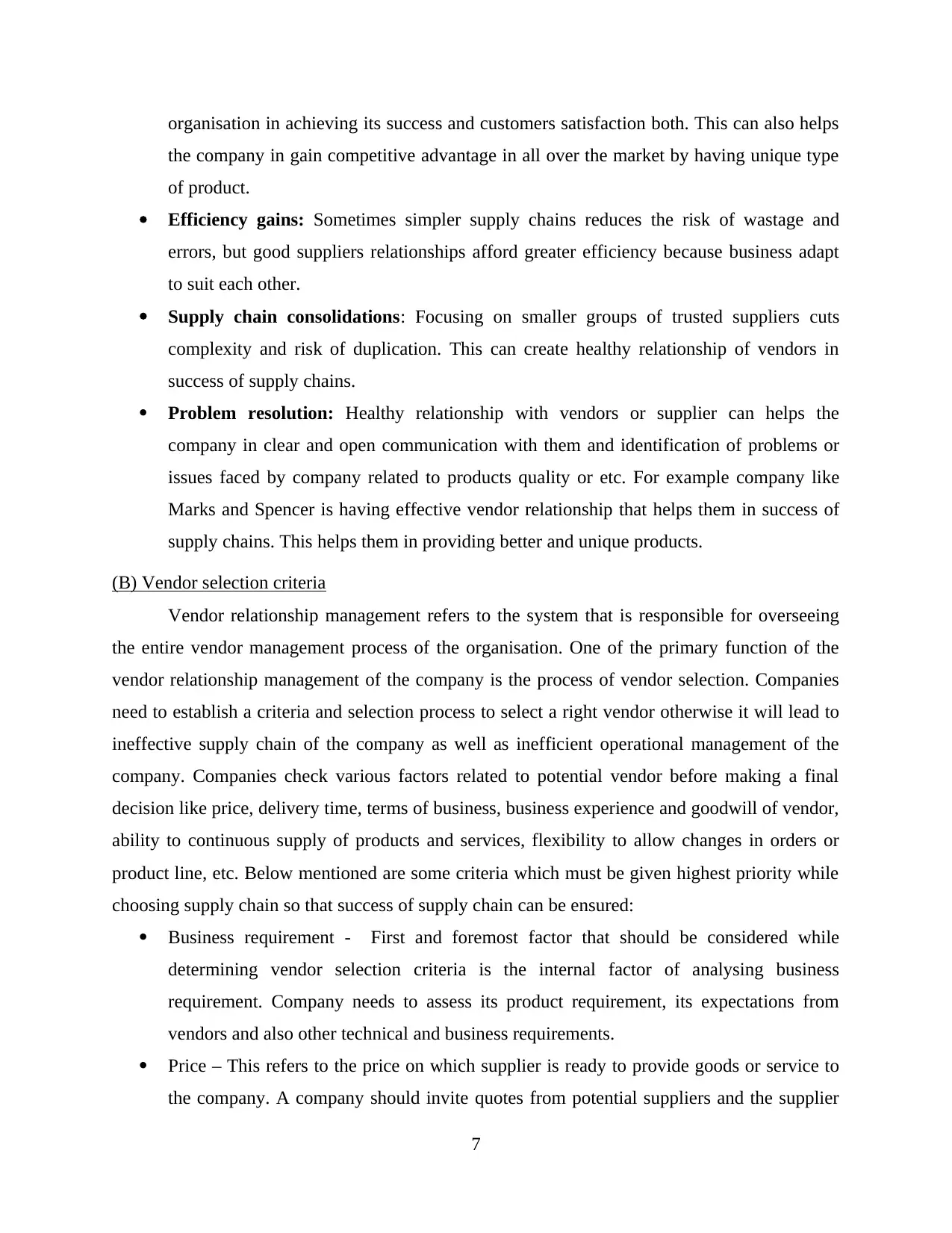
organisation in achieving its success and customers satisfaction both. This can also helps
the company in gain competitive advantage in all over the market by having unique type
of product.
Efficiency gains: Sometimes simpler supply chains reduces the risk of wastage and
errors, but good suppliers relationships afford greater efficiency because business adapt
to suit each other.
Supply chain consolidations: Focusing on smaller groups of trusted suppliers cuts
complexity and risk of duplication. This can create healthy relationship of vendors in
success of supply chains.
Problem resolution: Healthy relationship with vendors or supplier can helps the
company in clear and open communication with them and identification of problems or
issues faced by company related to products quality or etc. For example company like
Marks and Spencer is having effective vendor relationship that helps them in success of
supply chains. This helps them in providing better and unique products.
(B) Vendor selection criteria
Vendor relationship management refers to the system that is responsible for overseeing
the entire vendor management process of the organisation. One of the primary function of the
vendor relationship management of the company is the process of vendor selection. Companies
need to establish a criteria and selection process to select a right vendor otherwise it will lead to
ineffective supply chain of the company as well as inefficient operational management of the
company. Companies check various factors related to potential vendor before making a final
decision like price, delivery time, terms of business, business experience and goodwill of vendor,
ability to continuous supply of products and services, flexibility to allow changes in orders or
product line, etc. Below mentioned are some criteria which must be given highest priority while
choosing supply chain so that success of supply chain can be ensured:
Business requirement - First and foremost factor that should be considered while
determining vendor selection criteria is the internal factor of analysing business
requirement. Company needs to assess its product requirement, its expectations from
vendors and also other technical and business requirements.
Price – This refers to the price on which supplier is ready to provide goods or service to
the company. A company should invite quotes from potential suppliers and the supplier
7
the company in gain competitive advantage in all over the market by having unique type
of product.
Efficiency gains: Sometimes simpler supply chains reduces the risk of wastage and
errors, but good suppliers relationships afford greater efficiency because business adapt
to suit each other.
Supply chain consolidations: Focusing on smaller groups of trusted suppliers cuts
complexity and risk of duplication. This can create healthy relationship of vendors in
success of supply chains.
Problem resolution: Healthy relationship with vendors or supplier can helps the
company in clear and open communication with them and identification of problems or
issues faced by company related to products quality or etc. For example company like
Marks and Spencer is having effective vendor relationship that helps them in success of
supply chains. This helps them in providing better and unique products.
(B) Vendor selection criteria
Vendor relationship management refers to the system that is responsible for overseeing
the entire vendor management process of the organisation. One of the primary function of the
vendor relationship management of the company is the process of vendor selection. Companies
need to establish a criteria and selection process to select a right vendor otherwise it will lead to
ineffective supply chain of the company as well as inefficient operational management of the
company. Companies check various factors related to potential vendor before making a final
decision like price, delivery time, terms of business, business experience and goodwill of vendor,
ability to continuous supply of products and services, flexibility to allow changes in orders or
product line, etc. Below mentioned are some criteria which must be given highest priority while
choosing supply chain so that success of supply chain can be ensured:
Business requirement - First and foremost factor that should be considered while
determining vendor selection criteria is the internal factor of analysing business
requirement. Company needs to assess its product requirement, its expectations from
vendors and also other technical and business requirements.
Price – This refers to the price on which supplier is ready to provide goods or service to
the company. A company should invite quotes from potential suppliers and the supplier
7
Paraphrase This Document
Need a fresh take? Get an instant paraphrase of this document with our AI Paraphraser
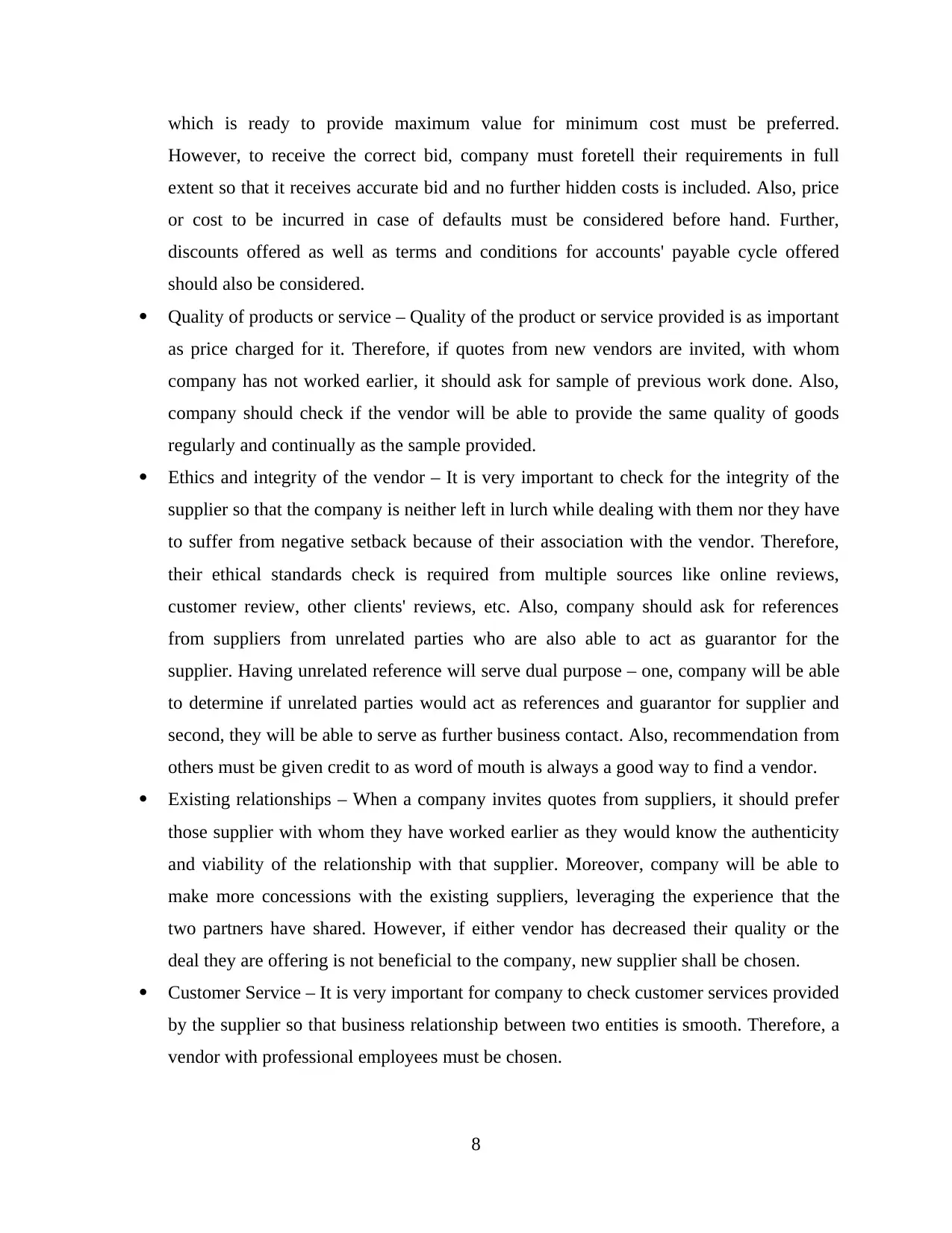
which is ready to provide maximum value for minimum cost must be preferred.
However, to receive the correct bid, company must foretell their requirements in full
extent so that it receives accurate bid and no further hidden costs is included. Also, price
or cost to be incurred in case of defaults must be considered before hand. Further,
discounts offered as well as terms and conditions for accounts' payable cycle offered
should also be considered.
Quality of products or service – Quality of the product or service provided is as important
as price charged for it. Therefore, if quotes from new vendors are invited, with whom
company has not worked earlier, it should ask for sample of previous work done. Also,
company should check if the vendor will be able to provide the same quality of goods
regularly and continually as the sample provided.
Ethics and integrity of the vendor – It is very important to check for the integrity of the
supplier so that the company is neither left in lurch while dealing with them nor they have
to suffer from negative setback because of their association with the vendor. Therefore,
their ethical standards check is required from multiple sources like online reviews,
customer review, other clients' reviews, etc. Also, company should ask for references
from suppliers from unrelated parties who are also able to act as guarantor for the
supplier. Having unrelated reference will serve dual purpose – one, company will be able
to determine if unrelated parties would act as references and guarantor for supplier and
second, they will be able to serve as further business contact. Also, recommendation from
others must be given credit to as word of mouth is always a good way to find a vendor.
Existing relationships – When a company invites quotes from suppliers, it should prefer
those supplier with whom they have worked earlier as they would know the authenticity
and viability of the relationship with that supplier. Moreover, company will be able to
make more concessions with the existing suppliers, leveraging the experience that the
two partners have shared. However, if either vendor has decreased their quality or the
deal they are offering is not beneficial to the company, new supplier shall be chosen.
Customer Service – It is very important for company to check customer services provided
by the supplier so that business relationship between two entities is smooth. Therefore, a
vendor with professional employees must be chosen.
8
However, to receive the correct bid, company must foretell their requirements in full
extent so that it receives accurate bid and no further hidden costs is included. Also, price
or cost to be incurred in case of defaults must be considered before hand. Further,
discounts offered as well as terms and conditions for accounts' payable cycle offered
should also be considered.
Quality of products or service – Quality of the product or service provided is as important
as price charged for it. Therefore, if quotes from new vendors are invited, with whom
company has not worked earlier, it should ask for sample of previous work done. Also,
company should check if the vendor will be able to provide the same quality of goods
regularly and continually as the sample provided.
Ethics and integrity of the vendor – It is very important to check for the integrity of the
supplier so that the company is neither left in lurch while dealing with them nor they have
to suffer from negative setback because of their association with the vendor. Therefore,
their ethical standards check is required from multiple sources like online reviews,
customer review, other clients' reviews, etc. Also, company should ask for references
from suppliers from unrelated parties who are also able to act as guarantor for the
supplier. Having unrelated reference will serve dual purpose – one, company will be able
to determine if unrelated parties would act as references and guarantor for supplier and
second, they will be able to serve as further business contact. Also, recommendation from
others must be given credit to as word of mouth is always a good way to find a vendor.
Existing relationships – When a company invites quotes from suppliers, it should prefer
those supplier with whom they have worked earlier as they would know the authenticity
and viability of the relationship with that supplier. Moreover, company will be able to
make more concessions with the existing suppliers, leveraging the experience that the
two partners have shared. However, if either vendor has decreased their quality or the
deal they are offering is not beneficial to the company, new supplier shall be chosen.
Customer Service – It is very important for company to check customer services provided
by the supplier so that business relationship between two entities is smooth. Therefore, a
vendor with professional employees must be chosen.
8
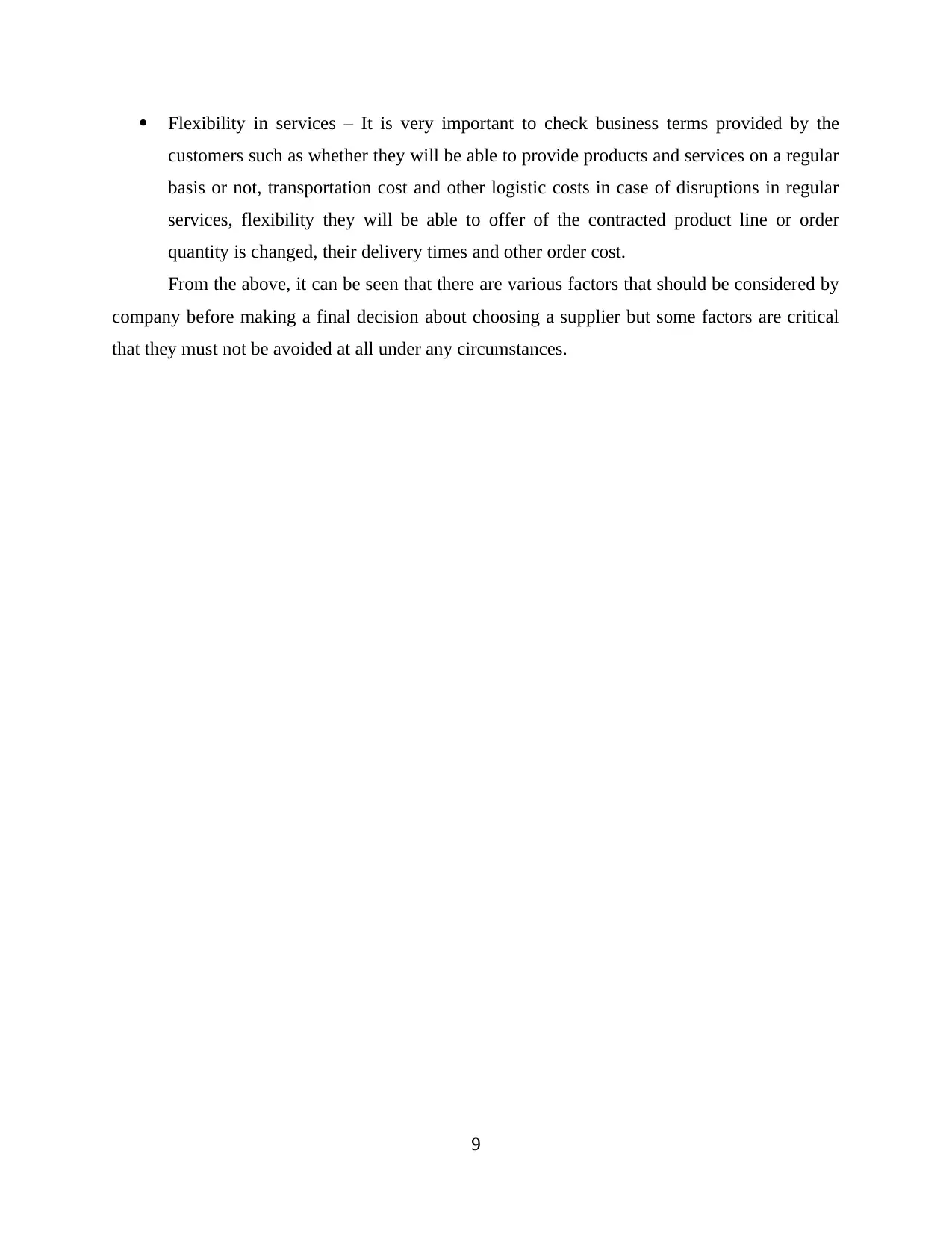
Flexibility in services – It is very important to check business terms provided by the
customers such as whether they will be able to provide products and services on a regular
basis or not, transportation cost and other logistic costs in case of disruptions in regular
services, flexibility they will be able to offer of the contracted product line or order
quantity is changed, their delivery times and other order cost.
From the above, it can be seen that there are various factors that should be considered by
company before making a final decision about choosing a supplier but some factors are critical
that they must not be avoided at all under any circumstances.
9
customers such as whether they will be able to provide products and services on a regular
basis or not, transportation cost and other logistic costs in case of disruptions in regular
services, flexibility they will be able to offer of the contracted product line or order
quantity is changed, their delivery times and other order cost.
From the above, it can be seen that there are various factors that should be considered by
company before making a final decision about choosing a supplier but some factors are critical
that they must not be avoided at all under any circumstances.
9
⊘ This is a preview!⊘
Do you want full access?
Subscribe today to unlock all pages.

Trusted by 1+ million students worldwide
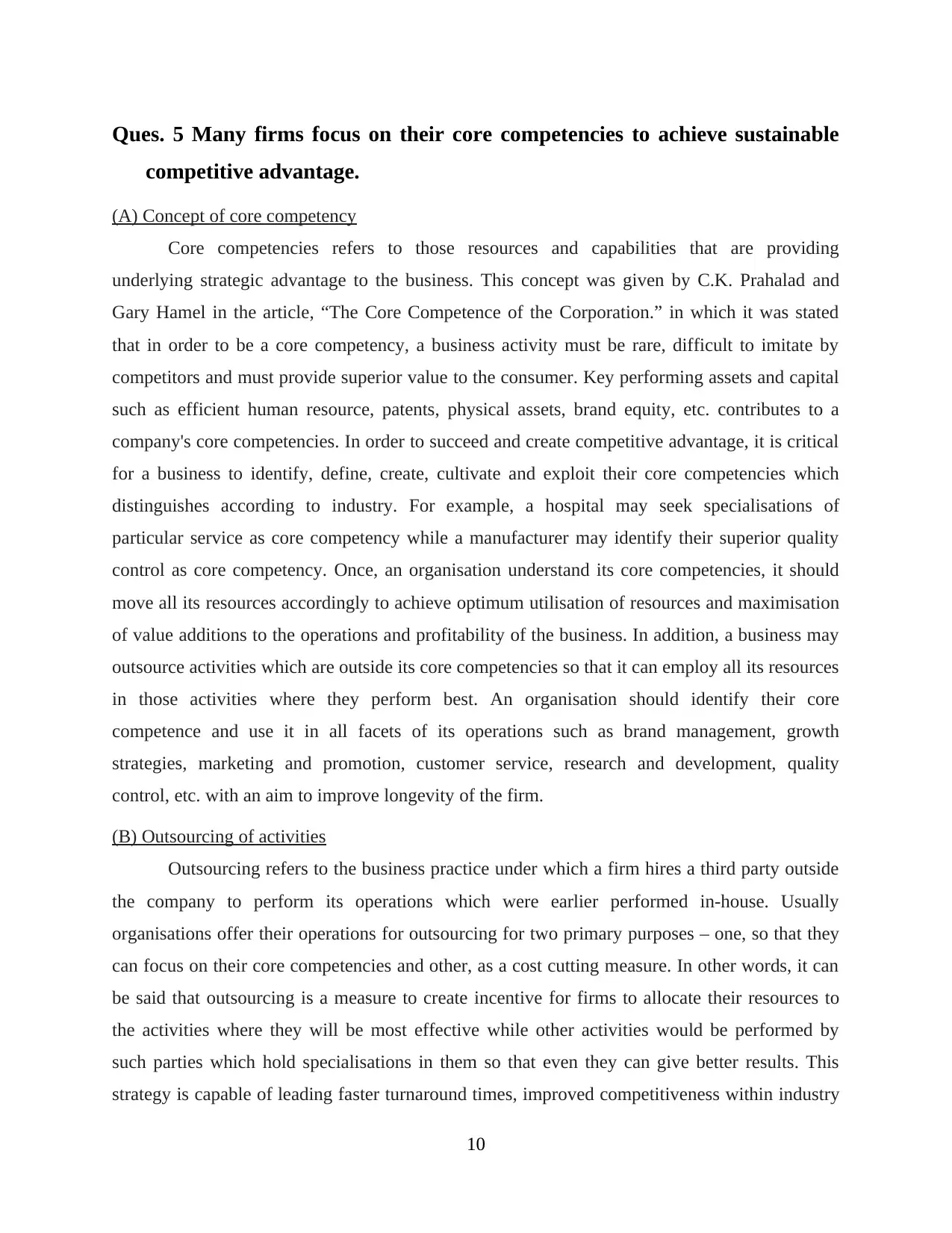
Ques. 5 Many firms focus on their core competencies to achieve sustainable
competitive advantage.
(A) Concept of core competency
Core competencies refers to those resources and capabilities that are providing
underlying strategic advantage to the business. This concept was given by C.K. Prahalad and
Gary Hamel in the article, “The Core Competence of the Corporation.” in which it was stated
that in order to be a core competency, a business activity must be rare, difficult to imitate by
competitors and must provide superior value to the consumer. Key performing assets and capital
such as efficient human resource, patents, physical assets, brand equity, etc. contributes to a
company's core competencies. In order to succeed and create competitive advantage, it is critical
for a business to identify, define, create, cultivate and exploit their core competencies which
distinguishes according to industry. For example, a hospital may seek specialisations of
particular service as core competency while a manufacturer may identify their superior quality
control as core competency. Once, an organisation understand its core competencies, it should
move all its resources accordingly to achieve optimum utilisation of resources and maximisation
of value additions to the operations and profitability of the business. In addition, a business may
outsource activities which are outside its core competencies so that it can employ all its resources
in those activities where they perform best. An organisation should identify their core
competence and use it in all facets of its operations such as brand management, growth
strategies, marketing and promotion, customer service, research and development, quality
control, etc. with an aim to improve longevity of the firm.
(B) Outsourcing of activities
Outsourcing refers to the business practice under which a firm hires a third party outside
the company to perform its operations which were earlier performed in-house. Usually
organisations offer their operations for outsourcing for two primary purposes – one, so that they
can focus on their core competencies and other, as a cost cutting measure. In other words, it can
be said that outsourcing is a measure to create incentive for firms to allocate their resources to
the activities where they will be most effective while other activities would be performed by
such parties which hold specialisations in them so that even they can give better results. This
strategy is capable of leading faster turnaround times, improved competitiveness within industry
10
competitive advantage.
(A) Concept of core competency
Core competencies refers to those resources and capabilities that are providing
underlying strategic advantage to the business. This concept was given by C.K. Prahalad and
Gary Hamel in the article, “The Core Competence of the Corporation.” in which it was stated
that in order to be a core competency, a business activity must be rare, difficult to imitate by
competitors and must provide superior value to the consumer. Key performing assets and capital
such as efficient human resource, patents, physical assets, brand equity, etc. contributes to a
company's core competencies. In order to succeed and create competitive advantage, it is critical
for a business to identify, define, create, cultivate and exploit their core competencies which
distinguishes according to industry. For example, a hospital may seek specialisations of
particular service as core competency while a manufacturer may identify their superior quality
control as core competency. Once, an organisation understand its core competencies, it should
move all its resources accordingly to achieve optimum utilisation of resources and maximisation
of value additions to the operations and profitability of the business. In addition, a business may
outsource activities which are outside its core competencies so that it can employ all its resources
in those activities where they perform best. An organisation should identify their core
competence and use it in all facets of its operations such as brand management, growth
strategies, marketing and promotion, customer service, research and development, quality
control, etc. with an aim to improve longevity of the firm.
(B) Outsourcing of activities
Outsourcing refers to the business practice under which a firm hires a third party outside
the company to perform its operations which were earlier performed in-house. Usually
organisations offer their operations for outsourcing for two primary purposes – one, so that they
can focus on their core competencies and other, as a cost cutting measure. In other words, it can
be said that outsourcing is a measure to create incentive for firms to allocate their resources to
the activities where they will be most effective while other activities would be performed by
such parties which hold specialisations in them so that even they can give better results. This
strategy is capable of leading faster turnaround times, improved competitiveness within industry
10
Paraphrase This Document
Need a fresh take? Get an instant paraphrase of this document with our AI Paraphraser
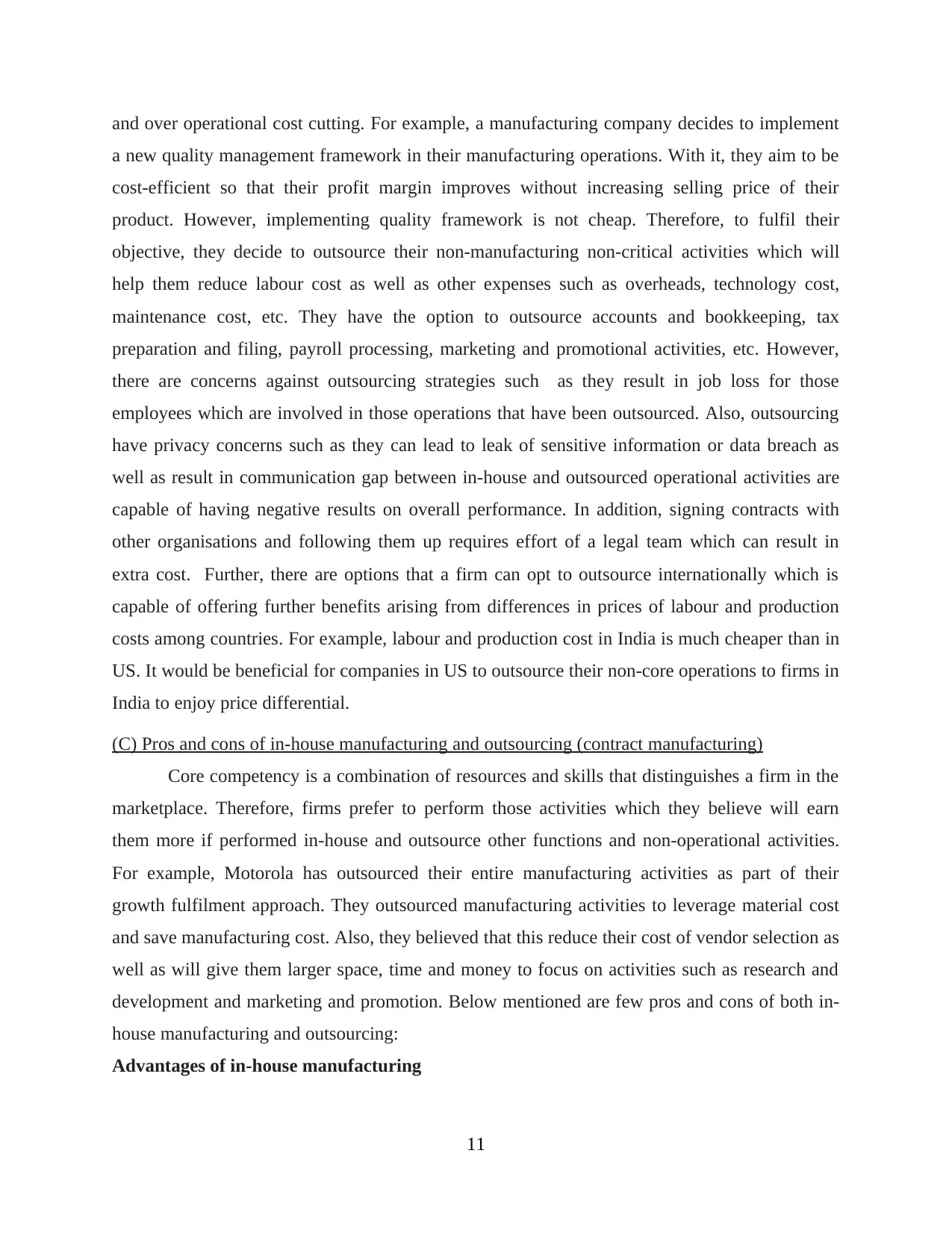
and over operational cost cutting. For example, a manufacturing company decides to implement
a new quality management framework in their manufacturing operations. With it, they aim to be
cost-efficient so that their profit margin improves without increasing selling price of their
product. However, implementing quality framework is not cheap. Therefore, to fulfil their
objective, they decide to outsource their non-manufacturing non-critical activities which will
help them reduce labour cost as well as other expenses such as overheads, technology cost,
maintenance cost, etc. They have the option to outsource accounts and bookkeeping, tax
preparation and filing, payroll processing, marketing and promotional activities, etc. However,
there are concerns against outsourcing strategies such as they result in job loss for those
employees which are involved in those operations that have been outsourced. Also, outsourcing
have privacy concerns such as they can lead to leak of sensitive information or data breach as
well as result in communication gap between in-house and outsourced operational activities are
capable of having negative results on overall performance. In addition, signing contracts with
other organisations and following them up requires effort of a legal team which can result in
extra cost. Further, there are options that a firm can opt to outsource internationally which is
capable of offering further benefits arising from differences in prices of labour and production
costs among countries. For example, labour and production cost in India is much cheaper than in
US. It would be beneficial for companies in US to outsource their non-core operations to firms in
India to enjoy price differential.
(C) Pros and cons of in-house manufacturing and outsourcing (contract manufacturing)
Core competency is a combination of resources and skills that distinguishes a firm in the
marketplace. Therefore, firms prefer to perform those activities which they believe will earn
them more if performed in-house and outsource other functions and non-operational activities.
For example, Motorola has outsourced their entire manufacturing activities as part of their
growth fulfilment approach. They outsourced manufacturing activities to leverage material cost
and save manufacturing cost. Also, they believed that this reduce their cost of vendor selection as
well as will give them larger space, time and money to focus on activities such as research and
development and marketing and promotion. Below mentioned are few pros and cons of both in-
house manufacturing and outsourcing:
Advantages of in-house manufacturing
11
a new quality management framework in their manufacturing operations. With it, they aim to be
cost-efficient so that their profit margin improves without increasing selling price of their
product. However, implementing quality framework is not cheap. Therefore, to fulfil their
objective, they decide to outsource their non-manufacturing non-critical activities which will
help them reduce labour cost as well as other expenses such as overheads, technology cost,
maintenance cost, etc. They have the option to outsource accounts and bookkeeping, tax
preparation and filing, payroll processing, marketing and promotional activities, etc. However,
there are concerns against outsourcing strategies such as they result in job loss for those
employees which are involved in those operations that have been outsourced. Also, outsourcing
have privacy concerns such as they can lead to leak of sensitive information or data breach as
well as result in communication gap between in-house and outsourced operational activities are
capable of having negative results on overall performance. In addition, signing contracts with
other organisations and following them up requires effort of a legal team which can result in
extra cost. Further, there are options that a firm can opt to outsource internationally which is
capable of offering further benefits arising from differences in prices of labour and production
costs among countries. For example, labour and production cost in India is much cheaper than in
US. It would be beneficial for companies in US to outsource their non-core operations to firms in
India to enjoy price differential.
(C) Pros and cons of in-house manufacturing and outsourcing (contract manufacturing)
Core competency is a combination of resources and skills that distinguishes a firm in the
marketplace. Therefore, firms prefer to perform those activities which they believe will earn
them more if performed in-house and outsource other functions and non-operational activities.
For example, Motorola has outsourced their entire manufacturing activities as part of their
growth fulfilment approach. They outsourced manufacturing activities to leverage material cost
and save manufacturing cost. Also, they believed that this reduce their cost of vendor selection as
well as will give them larger space, time and money to focus on activities such as research and
development and marketing and promotion. Below mentioned are few pros and cons of both in-
house manufacturing and outsourcing:
Advantages of in-house manufacturing
11
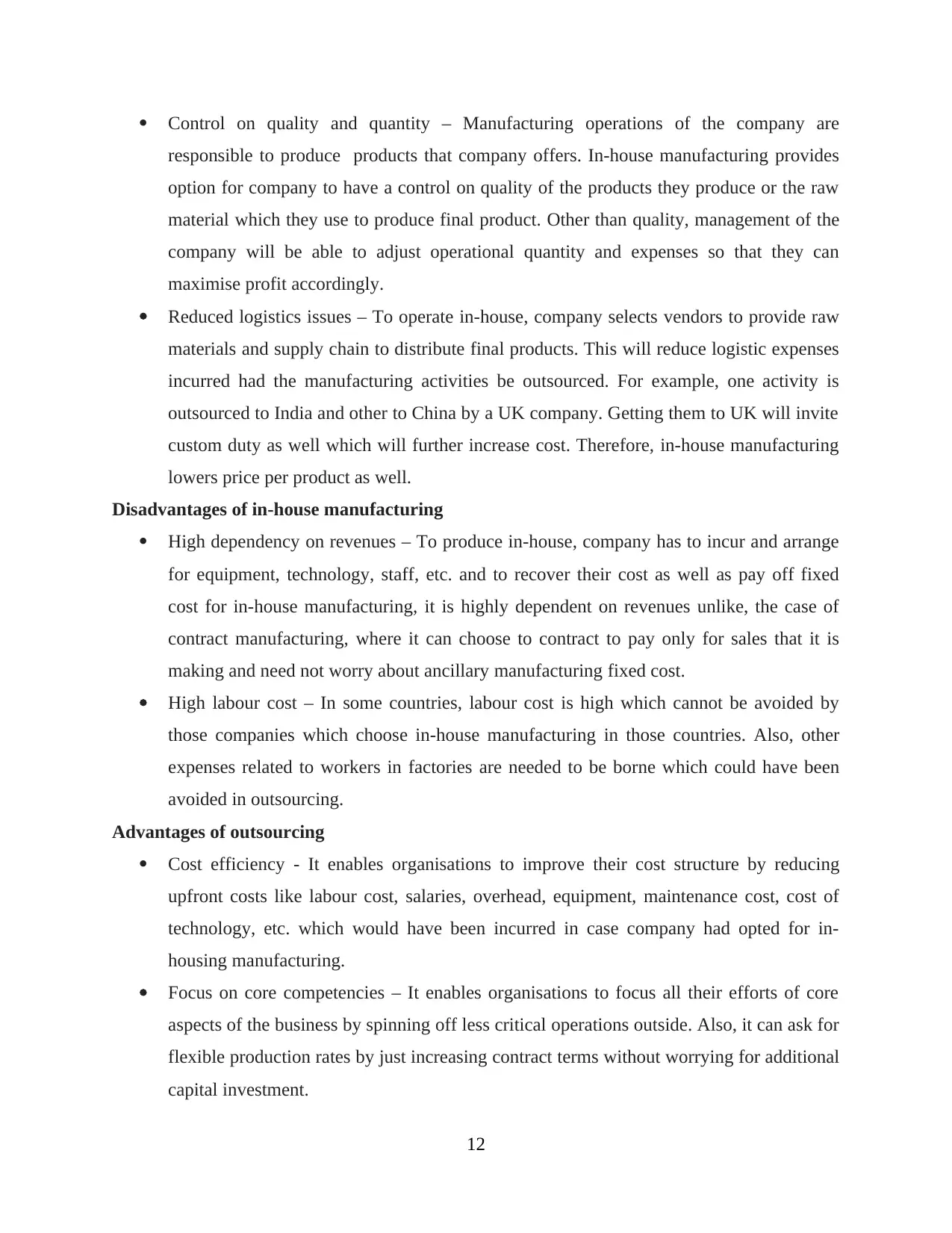
Control on quality and quantity – Manufacturing operations of the company are
responsible to produce products that company offers. In-house manufacturing provides
option for company to have a control on quality of the products they produce or the raw
material which they use to produce final product. Other than quality, management of the
company will be able to adjust operational quantity and expenses so that they can
maximise profit accordingly.
Reduced logistics issues – To operate in-house, company selects vendors to provide raw
materials and supply chain to distribute final products. This will reduce logistic expenses
incurred had the manufacturing activities be outsourced. For example, one activity is
outsourced to India and other to China by a UK company. Getting them to UK will invite
custom duty as well which will further increase cost. Therefore, in-house manufacturing
lowers price per product as well.
Disadvantages of in-house manufacturing
High dependency on revenues – To produce in-house, company has to incur and arrange
for equipment, technology, staff, etc. and to recover their cost as well as pay off fixed
cost for in-house manufacturing, it is highly dependent on revenues unlike, the case of
contract manufacturing, where it can choose to contract to pay only for sales that it is
making and need not worry about ancillary manufacturing fixed cost.
High labour cost – In some countries, labour cost is high which cannot be avoided by
those companies which choose in-house manufacturing in those countries. Also, other
expenses related to workers in factories are needed to be borne which could have been
avoided in outsourcing.
Advantages of outsourcing
Cost efficiency - It enables organisations to improve their cost structure by reducing
upfront costs like labour cost, salaries, overhead, equipment, maintenance cost, cost of
technology, etc. which would have been incurred in case company had opted for in-
housing manufacturing.
Focus on core competencies – It enables organisations to focus all their efforts of core
aspects of the business by spinning off less critical operations outside. Also, it can ask for
flexible production rates by just increasing contract terms without worrying for additional
capital investment.
12
responsible to produce products that company offers. In-house manufacturing provides
option for company to have a control on quality of the products they produce or the raw
material which they use to produce final product. Other than quality, management of the
company will be able to adjust operational quantity and expenses so that they can
maximise profit accordingly.
Reduced logistics issues – To operate in-house, company selects vendors to provide raw
materials and supply chain to distribute final products. This will reduce logistic expenses
incurred had the manufacturing activities be outsourced. For example, one activity is
outsourced to India and other to China by a UK company. Getting them to UK will invite
custom duty as well which will further increase cost. Therefore, in-house manufacturing
lowers price per product as well.
Disadvantages of in-house manufacturing
High dependency on revenues – To produce in-house, company has to incur and arrange
for equipment, technology, staff, etc. and to recover their cost as well as pay off fixed
cost for in-house manufacturing, it is highly dependent on revenues unlike, the case of
contract manufacturing, where it can choose to contract to pay only for sales that it is
making and need not worry about ancillary manufacturing fixed cost.
High labour cost – In some countries, labour cost is high which cannot be avoided by
those companies which choose in-house manufacturing in those countries. Also, other
expenses related to workers in factories are needed to be borne which could have been
avoided in outsourcing.
Advantages of outsourcing
Cost efficiency - It enables organisations to improve their cost structure by reducing
upfront costs like labour cost, salaries, overhead, equipment, maintenance cost, cost of
technology, etc. which would have been incurred in case company had opted for in-
housing manufacturing.
Focus on core competencies – It enables organisations to focus all their efforts of core
aspects of the business by spinning off less critical operations outside. Also, it can ask for
flexible production rates by just increasing contract terms without worrying for additional
capital investment.
12
⊘ This is a preview!⊘
Do you want full access?
Subscribe today to unlock all pages.

Trusted by 1+ million students worldwide
1 out of 13
Related Documents
Your All-in-One AI-Powered Toolkit for Academic Success.
+13062052269
info@desklib.com
Available 24*7 on WhatsApp / Email
![[object Object]](/_next/static/media/star-bottom.7253800d.svg)
Unlock your academic potential
Copyright © 2020–2025 A2Z Services. All Rights Reserved. Developed and managed by ZUCOL.





